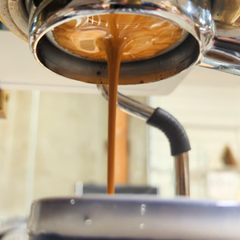What is Extraction in Espresso?
Why does everyone keep talking about extraction and what does it mean? Isn't it a movie starring Chris Hemsworth? (It is.) But in espresso, extraction is what the water does when it comes in contact with the ground coffee, pulling out the dissolvable bits (flavor compounds) and putting it in your cup.
People have noted over 800 flavor notes in coffee after roasting! All the steps we take- freshly roasted beans, evenly ground coffee, using soft, filtered water at just the right temperature- are meant to optimize extraction and let you taste the notes in your particular coffee.
Well-extracted doesn't mean getting everything out of the beans, though- it means getting the delicious flavor compounds into your cup while leaving the not-good compounds behind.
Every coffee bean is only about 30% soluble - meaning only 30% of the coffee bean provides flavor (the rest of it is either insoluble plant fiber, or oils that provide body to your drink.) Out of that, though, most coffee industry pros agree that the ideal extraction is somewhere between 18 - 22%. Less than that, and you may have a sour shot. More risks a tannic, mouth drying, bitter coffee.
Whether you are making a French press, pour over, or espresso, extraction always happens in the same order:
ACIDITY/OILS-- Bright, acidic flavors, as well as floral notes, are pulled out first, as they are the most simple compounds in the coffee. Oils from the coffee bean also dissolve in the initial part of the brew.
SUGARS- Sugars (carbohydrates) in the coffee beans are developed in the roasting process, making them easier to taste and more aromatic. These require a little more time to dissolve than the acidic compounds, so they come next.
BITTERNESS- After pulling out the acidity and sweetness from the ground coffee, water will start to pull out the naturally occurring tannins, which can bring bitterness and a dry feeling to your mouth as you taste them.
The beginning of a shot, characterized by slow, syrupy drips,

eventually becomes a thick, striped stream of espresso. (Those stripes are a combination of actual tiny particles of coffee and emulsified coffee oils).


As the shot progresses, and the water has pulled most of the dissolvable compounds, the stream begins to thin out and look "blonde."

Though all coffee brewing methods go through this in the same order, espresso makes it more interesting (i.e., annoying) by speeding everything up with high pressure water and very finely ground coffee, so even the smallest change can make a huge difference in your extractions.
For more information and espresso tips, check out the rest of the blog! We're adding more resources all the time!